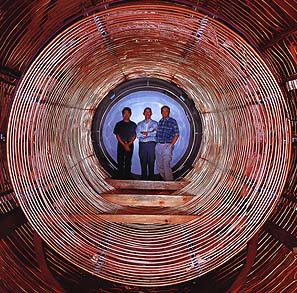
 Left: Enrique Henestroza, Joe Kwan, and Lou Reginato are among the Berkeley Lab scientists and engineers constructing a proton accelerator that will be a key element in a promising new treatment for brain cancer called Boron Neutron Capture Therapy.
Left: Enrique Henestroza, Joe Kwan, and Lou Reginato are among the Berkeley Lab scientists and engineers constructing a proton accelerator that will be a key element in a promising new treatment for brain cancer called Boron Neutron Capture Therapy.
Glioblastoma multiforme, cancer of the brain. Also known as "octopus tumors" because of the manner in which the cancer cells extend their tendrils into surrounding healthy brain tissue, the disease is virtually inoperable, resistant to conventional radiation therapies, and always fatal, usually within six months of onset. Each year, glioblastoma multiforme kills approximately 15,000 people in the United States.
There is one experimental procedure that has tantalized researchers with the prospects of a successful treatment. Called boron neutron capture therapy, or BNCT, the hopes raised by this procedure have been clouded by the questionable prospects of convincing hospitals to allow the installation and operation of a nuclear reactor on their premises. The cloud, however, may soon be lifted. Several of the top research institutes on the West Coast are collaborating on a proposal to test the feasibility of performing BNCT with a particle accelerator rather than a nuclear reactor. Leading this collaboration and participating in all the key stages are researchers at Berkeley Lab and the University of California at San Francisco (UCSF).
